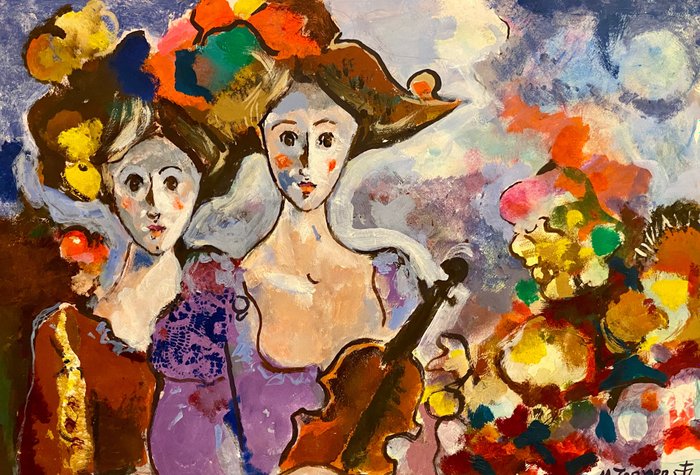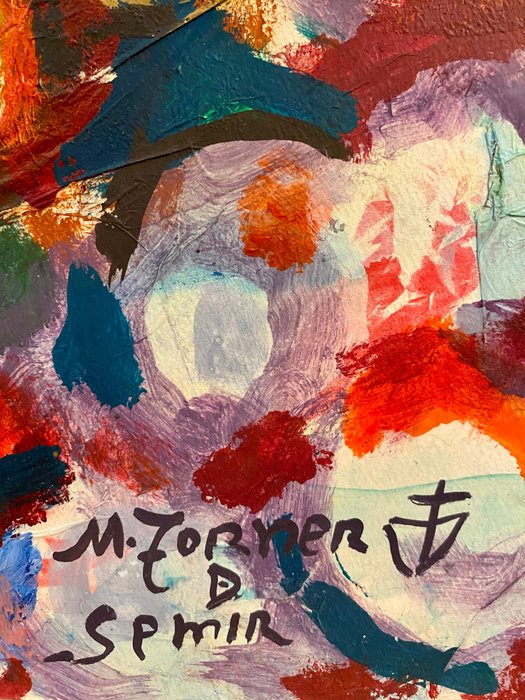Advert Description
Are you interested in this item? This item is up for auction at Catawiki. Please click on "respond to advert" (orange button) to get redirected to the Catawiki website. Catawiki’s goal is to make special objects universally available. Our weekly auctions feature thousands of unusual, rare, and exceptional objects you won’t find in just any store. Oil glued to board
Signed bottom corner
Miquel Torner de Semir was born in 1938 of the last century in the castle of Santa Pau, in La Garrotxa (Gerona), being the last person alive born in this emblematic construction surrounded by volcanoes (he currently lives in San Feliu de Guísols). . This fact marks his facet as a painter. A cultured man from old Catalonia, he has always been attracted to the Middle Ages, the Romanesque of the Pyrenees and the early Gothic. The trail of Italian Renaissance art, especially Italian Quattrocento painters – not like Fra Angélico or Raphael – is felt in many female portraits by Torner de Semir, such as the one in question. It is precisely this mix between the old and the new where the originality of his work lies. What seems to have shaped him the most is his knowledge of Romanesque and Gothic. His figures on multiple occasions bordered by a thick dark line, evoke us the gothic stained glass windows, luminous, beautiful in and of themselves. Disciple of the muralist painter and engraver Ricard Marlet, he learns what is most important to him, the discipline of drawing. With the master Marlet he knows Catalan Modernism and New Centism. He studied at the Sant Jordi School of Fine Arts in Barcelona and at the San Fernando School in Madrid, where he will visit the Prado Museum and become impregnated with Velázquez's painting, choosing to reproduce the meninas to his liking, with his own style, with shades of vivid colors such as pink and phosphorescent violet that leave no doubt about the artist's highlight, modernity and friendliness. In addition, if one observes carefully, one can find the artist's use of the collage technique, which decides to embed a piece of fabric, cardboard or even a musical score.
In Paris, he begins his work as he calls "between the old and the new". He began holding individual exhibitions in Terrassa in 1968, later doing so in other Catalan cities and in Paris (Espace and Boutique galleries). His work began with a Mediterranean figurativism, later leading to abstraction, to return to a figuration of a modern concept. He is considered, in short, one of the most important exponents of Mediterranean painting.
All these trends were not unknown to him since in Barcelona he had had the opportunity to meet the Dau al Set group. In the Dau al Set school he meets artists as renowned as Tharrats, Muxart or Tapies. His painting is characterized by the use of vivid and rich colors. His work can be defined in a single word LIFE. Thus, the magnificent work of this Catalan painter is characterized by its rich and colorful paste of great vivacity, which together with the various materials he uses as a support, gives us the result of an expressionist painting of high chromatic quality and marked personality, defining the artist as teacher.
The classic and the new merge between the brush of Miquel Torner de Semir. Time dissolves, it fades. The dividing line between the past and the present is erased with his paintings, with his way of drawing on the canvas. Miquel achieves what very few have achieved before: speaking of the past with the voice of the present. His voice: his paintings. His method: passion. His achievement: all his work.
The Girona painter is influenced by the ancients, Giotto, the Italian Renaissance and by the informal search of abstract painters. All this is the starting point of his painting; he cares as much or more about the trade than the concept, he has tried to be a bridge painter between the past and the present, but also open to everything new, to the constant search. An interesting contrast in Miquel's work is the way in which he presents people, places and situations from ancient times captured with modern painting techniques. This famous Catalan painter has been able to break with the rules of time. So direct is Miquel Torner de Semir in defining the lines and shapes, that sometimes it is incredible that the work is a 2-dimensional canvas, it seems at first glance that the painting is rather a sum of textures of a three-dimensional world.
Some of his works have a prominent Faubist accent, with an intense and expressive color palette, in contrast to the serenity and empty gaze of the faces that invite the observer to enter the environment of the artist's work and thought. However, Torner de Semir has his own style based on the simplicity of the production within a very well-structured composition. The female figures have the leisurely forms of religious art and express the calm of the spirit. The figure serves Semir to reclaim the order and rhythm of human actions.
According to Joan Lluís Montañé, from Barcelona, member of the International Association of Art Critics, the prestigious Catalan painter Torner de Semir, in his extensive pictorial work, "is interested in composition and colour, generating specially elaborated creations , where the imprint of determination and the contrasting color palette are noticeable.It exhibits figures, landscapes and compositions that represent a clear exercise in pictorial academicism in which it does not renounce a certain formal and technical innovation, all within an unmistakable stamp personal plastic.
The art critic, Josep M. Cadena says of Semir: "The painter marks the silhouettes of the main elements of each composition with strong and precise lines and uses basic and pure colors to express feelings. Whenever possible, he makes the painting within the painting. , and he still tries to put abstract interpretations and signs in his backgrounds.Thus he achieves a positive relationship between the various forms of artistic expression that motivate him and his plastic language is much richer and more attractive.He has his own style that is based on the simplicity of the realization within a very well structured composition. His female figures have paused forms of religious art and express the calm that the realizations of the spirit must obey. The figure serves him to ask for order and rhythm in human actions, his painting it is ethical. It easily communicates positive sensations in those who know its work".
For J.Llop S.: "The drawing, the fundamental, strong, precise, incisive stroke, establishes the form, delimits spaces in the thoughtful compositions that Torner de Semir presents us. And then comes seeing in a different way, the imaginative, dreams arrive that connect with the reality that it describes and dresses with a chromaticism that combines basic colors, soft tones. It is a personal style that discovers the other reality of the landscape, of the figure. Interesting and attractive work that catches the viewer and leads down the path of the imaginative".
Consistent with his vision of the primitives, he has not worried too much about his social projection towards his teachers, these were sometimes unnamed and despite the fact that his works are in many countries, he has exhibited in Europe, America and Japan, it is difficult to do a comprehensive compilation of your resume. He currently exhibits, permanently, at the Arcadia Gallery in Madrid.
In 2003 he was chosen by the Royal Mint Museum, so that one of his works would be published on a postage stamp and participate in the exhibition of the 25th anniversary of the Spanish Constitution. Meanwhile, the Royal Mint Museum in Madrid has organized an exhibition of his works.
Torner's works have been exhibited in a large number of European and Spanish cities such as: Paris, Brussels, Frankfurt, Heidelberg, Strasbourg, Saint Paul de Vence, Dijon, Clermont-Ferrand, Barcelona, Gerona, Valencia, Seville, Pontevedra, Oviedo, etc. Let's see, below, some of his most important exhibitions of the Catalan artist:
MOST SIGNIFICANT EXHIBITIONS
Friends of the Arts. Terrassa-Barcelona.
Gallery. Sabadell-Barcelona.
Society of Independent Artists. Paris.
Grand Palace. Paris.
Dan Art, Béiziers-France.
Space Gallery. Paris-Beaubourg.
Lions Club. Chartres Doyen – France.
Guest of honor at the Cercle Espanyol exhibition. Dreux-France.
Salon d'Autome. Clermont-Ferrant – France.
Grand Prix la Famme et l'Imabonaire Jeanne Gatineau. Paris.
Gabina room. Palamos-Girona.
Clará Room, Olot-Barcelona.
Cultural Space Francolí-Barcelona.
Gallery Boutique. Paris France.
The Gallery of the Hotel Meridien. Paris.
L'Atelier. Platja d´Aro.Girona.
Ausstellungsraume der Mineralquelle Epitigen.Switzerland.
Arcadia Gallery- Madrid.
Star Art Gallery. Collective. Madrid.
Gallery 4 Cantons. Olot.Girona.
Catalonia-Barcelona Gallery.
Art 16 Gallery. Olot. Girona.
Pedreguet Contemporary Art Space. Gerona.
Da Vinci Art Gallery. Girona.
Galerie Ducs de Dijon.France.
Campo u Campo Gallery. Belgium.
Gallery B.C.S. Strasbourg.France.
Haus Arnold. Frankfurt am Main.Germany.
Haus Berlinghoff. Heidelberg.Germany.
Naumilenium. Barcelona.
Lart century art. Barcelona.
Royal Nautical Club of Sanxenxo. Pontevedra.
Picassomio.com Madrid.
Galeries d'Art Christian Dazy. Dijon-Megéve-France.
Commemorative Exhibition of the 25th Anniversary of the Spanish Constitution. Madrid.
Constanti Art Room, Reus. Christmas Collective, 2009-Tarragona.
As the praise is better for the spectator himself, we are going to list the artists present. Then judge.
Painters: Cerefino Olivé, Palau Ferré, Guerrero Llabería, Morató Aragonés, J. Soler, J. Queralt, Vicente Romero, Judith Jansá, Josep M. Munté, J. Roig, Abelló, Montesol, Agustina Sobrino, Roelán, Miquel Torner deSemir, De la Cruz, Joaquín Bolda, Ricardo Soler, Domingo Álvarez, Vives Fierro, María Dolors Trench, Joan Martí, Aguilar Moré, Rafael Romeo, Tito Figueras, Joan Colomer, Luis Bolivar and Marta Argentina.
Cervantes6-Oviedo Gallery.
Given the magnificent work of the painter, characterized by its rich and vivid colors, the Cervantes6 Gallery in Oviedo has surrendered to him and has chosen him for its new exhibition. The exhibition was inaugurated on June 5, 2010, in Oviedo, it remained open until June 27 and, in it, more than 20 works by the author were exhibited.
In 2003 Miquel Torner participated in the exhibition of the XXV Anniversary of the Spanish Constitution convened by the Royal Mint Museum, one of his works (73X60 cm harlequin figure) being chosen to be published by the factory Nacional de Moneda y Timbre on a postage stamp commemorating the 25th Anniversary of the Spanish Constitution. 67581817





